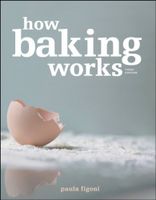Advertisement
Questions for Review
Appears in
By Paula Figoni
Published 2003
- Why is wheat so commonly used in the bakeshop? Why not flour from another cereal grain?
- Identify the three main parts of a wheat kernel. Which is/are milled into white flour? Which is/are milled into whole wheat flour?
- What is another name for wheat flour?
- Which of the following are not necessarily whole grains: Nine-grain bread, stone-ground flour, organic flour, graham flour?
- What are the two main types of dietary fiber? What are the primary health benefits of each?
- What components are naturally present in white flour? That is, what is the makeup of the wheat endosperm?
- Which component in white flour (in the wheat endosperm) is present in larger amounts than all other components combined?
- What is ash composed of? How is it measured in flour?
- Which of the three main parts of the wheat kernel is highest in ash?
- What are the main differences between flours milled from hard wheat and those milled from soft wheat?
- What is the difference between flour and meal?
- What is added to flour to enrich it? What is lost from milling wheat kernels into white flour that is not replaced with enrichment?
- What is meant by “green flour”?
- What are the two main changes brought about by naturally aging flour?
- What are the disadvantages of naturally aging flour?
- Provide an explanation for the advantages of maturing agents that strengthen.
- What is the standard maturing agent for hard wheat flours, the one that all others are judged against?
- Which maturing agent has been shown to be a carcinogen?
- Name a bromate replacer. How does it act differently than potassium bromate?
- Are potassium bromate and bromate replacers more likely to be added to bread flour or to cake flour? Why?
- Name the most common bleaching agent for flour.
- Name three effects of chlorine on flour. Which appears to be the most critical function of the three?
- Is chlorine more likely to be added to bread flours or to cake flours? Why?
- Why might flour contain a small amount of added amylase or malted barley flour?
- What is meant by “patent flour”?
- How does clear flour differ from straight flour? What is the main use for clear flour?
- How much higher in protein is the typical high-gluten flour compared with the typical bread flour? What additives are commonly added to high-gluten flour to further increase the structure-building and water-absorption abilities of the flour?
- How is artisan bread flour different from regular bread flour? How do these differences affect the qualities of baked bread?
- How much lower in protein is the typical cake flour compared with the typical pastry flour? What else is different between cake flour and pastry flour that can explain their different properties?
- What is used instead of chlorination to treat flour for use in cakes in countries that do not allow the chlorination of flour?
- Which of the following are whole grains: cracked wheat, whole wheat flour, wheat berries, wheat flour, durum flour, durum semolina, whole white wheat flour, clear flour?
- What are the differences in color, flavor, and dietary fiber between regular whole wheat flour and whole white wheat flour?
- Why does whole wheat flour have a shorter shelf life than white flour?
- Which of the following are usually milled from hard wheat and which from soft wheat: high-gluten flour, bread flour, artisan bread flour, pastry flour, cake flour, all-purpose flour?
- Which contains more carotenoids: bread flour or durum flour? How does the amount of carotenoids affect the appearance of flour?
- One function of flour is to provide structure or toughening. What structure builder forms from glutenin and gliadin when flour is mixed with water? What else in flour provides structure?
- One function of flour is that it is a drier. What three components in wheat flour absorb water and function as driers?
- What is meant by the “absorption value” of flour? How can you generally predict which of two flours will absorb more water?
- You normally use regular bread flour in a formula and switch to high-gluten flour. Will you need more water or less water to fully develop the gluten? Explain your answer.
- Why does bread flour absorb more water than pastry flour?
- Why does cake flour absorb more water than pastry flour?
- Why does flour have a limited shelf life? That is, why should it be stored for no longer than six months?
- Are you more likely to find silky cobwebs in whole wheat flour or in white flour? What causes these webs to form, and what should you do about it?

